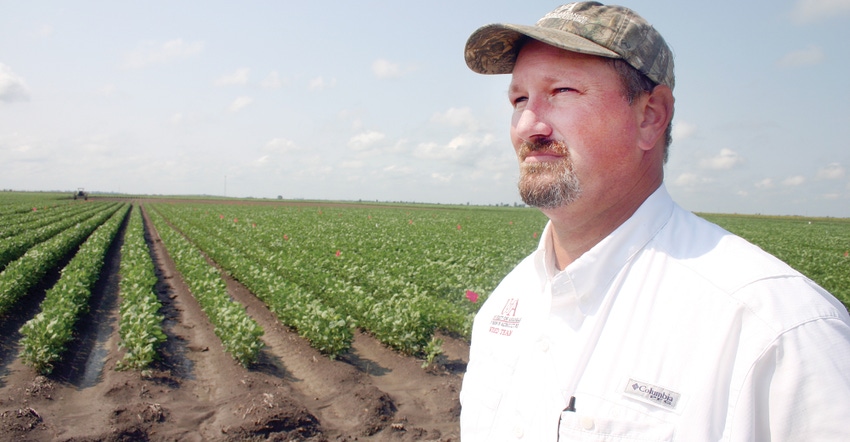
Those who picked Aug. 8 for the Northeast Research and Extension Center field day did everyone a favor. The weather is perfect — balmy but breezy, although fields were hit with a recent rain.
Full trailers of field day attendees pull through muddy turnrows as Jason Norsworthy, University of Arkansas weed scientist, steps out of heavily flagged field. It won’t be a surprise to know he’s been doing research on dicamba. What is surprising is some of his team’s findings.
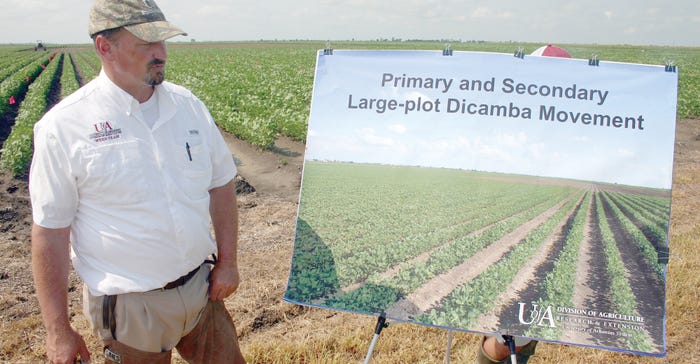
“What we’re looking at is primary and secondary movement of dicamba. What we’re showing in the center of the field is 3.5 acres treated with a labeled application of XtendiMax. We also made a labeled application of Engenia to 3.5 acres in an adjacent 20-acre field. Those applications were made simultaneously under the same environmental conditions.
“What we’re starting with is the fact we see dicamba damage throughout the field on two sides.”
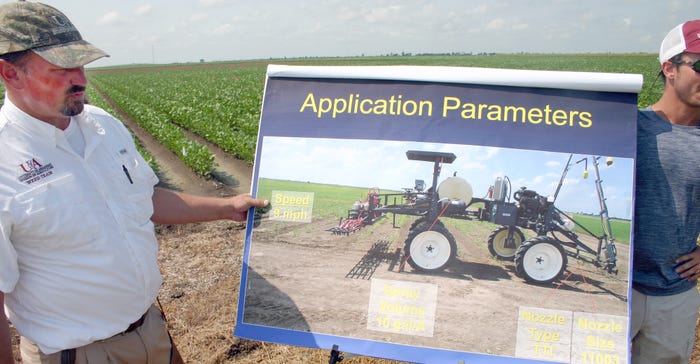
“When we take a look at the applications made to these fields, there was a ground speed of 9 miles per hour, a spray volume of 10 gallons, and we used a TTI 11003 nozzle and an eight-row sprayer.”
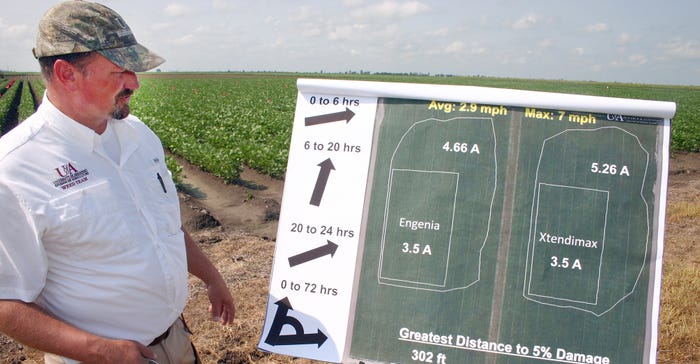
“We came back 12 days after application and mapped the periphery of the field where we saw 5 percent damage. We had 4.66 acres damage with Engenia and 5.26 acres damaged with Xtendimax. During the application, the average wind speed was 2.9 miles per hour and the maximum wind speed was a gust of up to 7 miles per hour.
“The product moved out to 302 feet with Engenia and 303 Xtendimax. I remind you that was at 12 days after application. You’d expect the damage to increase out to 21 days, possibly 28 days, after application.
“When we look at the diagrams, you’ll notice damage on two sides of the field. The reason for that is during application, we had a westward wind. That led to damage on the east side of the field.
“Six hours after application, the wind actually changed direction and blew out of the south. So the damage to the north occurred because we had volatilization from these treated areas and the herbicide picked up and moved north and damaged the areas that we see on the north end.
“Between 20 and 24 hours after application, the wind shifted back — mainly westward. We had buckets in the fields covering some plants that were pulled a half hour after application. So, any of the damage to those plants under the buckets appears to be due to volatilization.
“Also, over the 72-hour period following application, the wind blew out of the south or west — never any other direction.”
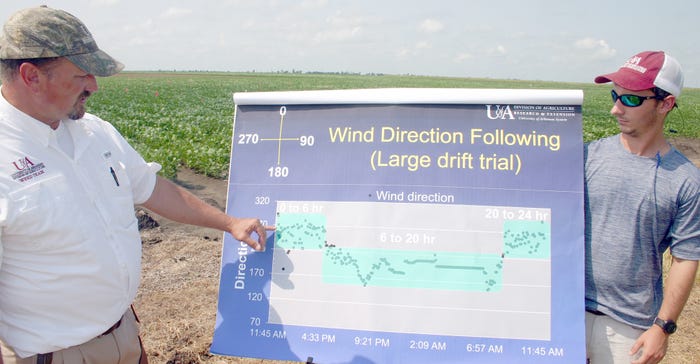
“We had a weather station in the field and the wind was mainly coming out of the west. From six to 20 hours, it then shifted to about 180/190 degrees coming out of the south. Then, the wind shifted back to the west from 20 to 24 hours.”
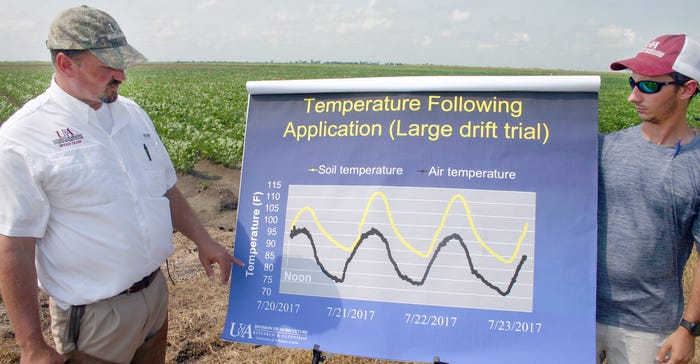
“We know temperature has a direct impact on the volatility of a product. At the time of application, we were at 93/94 degrees when we sprayed the two fields simultaneously. We got up to about 97/98 degrees later that day. Over the next three days, we had low air temperatures of about 75 to 77 degrees.
“But pay attention to the soil temperatures. We had a run of 106 degrees the first day, 113 the second day and 113 the third day. So, when you talk about volatility it’s the ability through temperature to convert a liquid to a gas. So, any material lying on the soil surface has a high potential to volatilize — especially when we’re experiencing these high temperatures.
“The other take-home from this is: don’t just pay attention to the air temperature. At the end of the day, folks monitoring the air temp thinking they’re monitoring the possibility of volatility may not be doing a complete job, the soil temperature may be more important.”
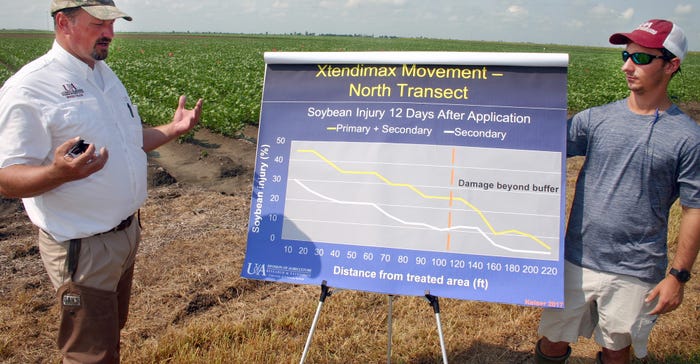
“This is the actual data 12 days after application — one of four transects in the field where we had buckets and no buckets over plants. The primary and secondary movement is a combination of physical drift plus volatility.
“Notice we move from 10 to 220 feet in an eastward direction. Out to 110 feet there’s a buffer according to the current Xtendimax and Engenia labels; however, we see 25 percent damage at 12 days after application at this distance as well as damage beyond this point.
“We also placed plants in the treated area 0.5 and 24 hours after application and these plants were severely damaged. Also, plants that were under buckets outside of the treated area for the first 0.5 hour after application experienced damage. Is the product volatilizing and causing damage to plants under the buckets? Absolutely. We see damage out to 220 feet, all the way to the edge of the field.”
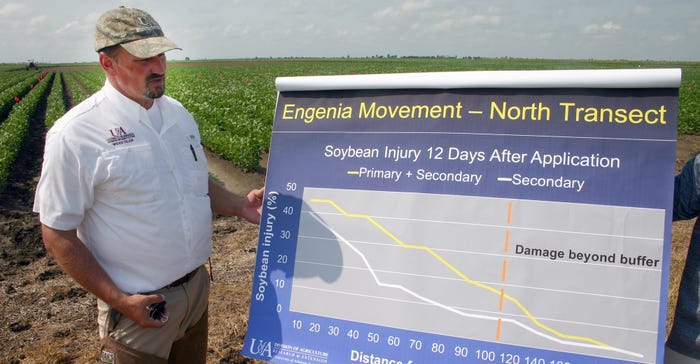
“So, what about Engenia? There was a similar response. At 110 feet damage was down to 18 percent damage rather than 25. But, overall, the trends hold constant. Both products are moving off-target due to secondary movement, likely volatility."
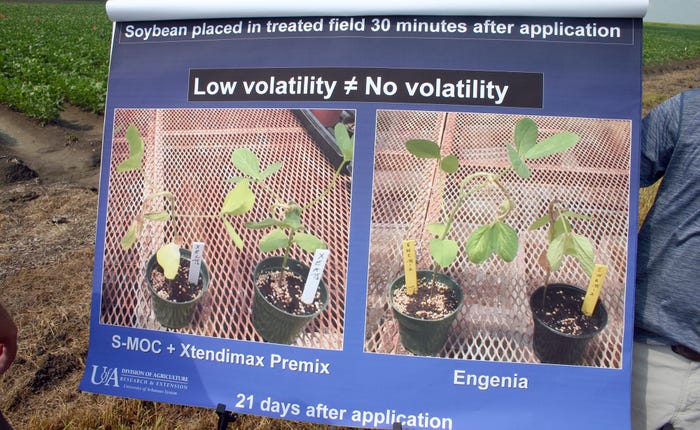
“Check out the white flags in the field. We brought soybean from the greenhouse and set them beside the white flags a half-hour after spraying. We left them out there from 30 minutes to 36 hours after spraying. Those plants were never sprayed and showed considerable damage.
“We also took greenhouse plants to the field 24 hours after spraying. We left those out to 36 hours — so they were out there 12 hours. Those plants, too, showed considerable damage from volatility.
“So, we have products that appear to be volatilizing for at least 36 hours in these fields.”
It could be more than 36 hours?
“Yeah, it could. We just stopped the study at 36 hours.”
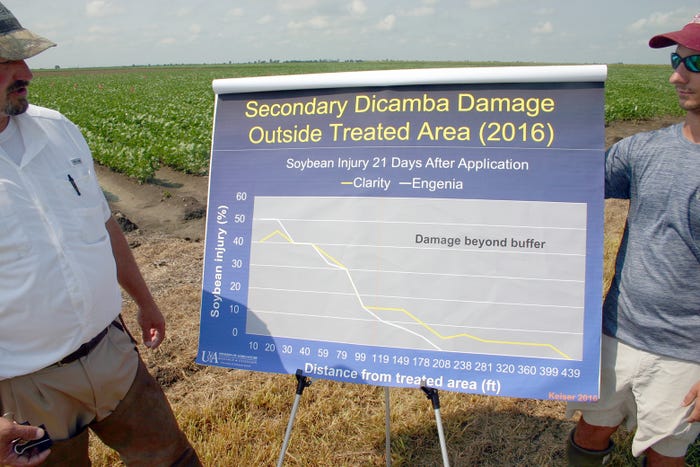
“We were never allowed to study Xtendimax prior to registration.
“We did some work with Engenia where in 2016 we treated a third of an acre with Engenia and a third of an acre with Clarity. You’ll see there are eight cardinal directions from which we took assessments.
“With a labeled application of Engenia, if I’m looking at secondary movement, we saw out to about 110 feet a similar response for both Clarity and Engenia. But beyond 110 feet, we did see greater damage with Clarity than with Engenia. That were the data the Arkansas State Plant Board ultimately used to allow use of Engenia within the state and to restrict the use of Clarity and other formulations beyond April 15. The board also did not permit Xtendimax use beyond April 15.”
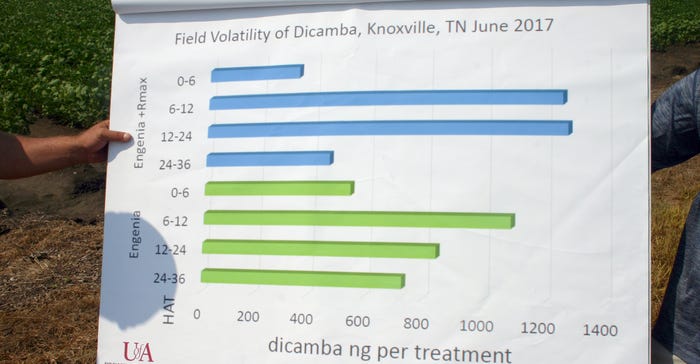
“Are we the only ones seeing such results? No.
“These data are from Dr. Tom Mueller in Tennessee. Dr. Mueller sprayed Engenia plus Roundup in a field and Engenia by itself in another. He then took air samples at zero-to-six hours, six-to-12 hours, 12-to-24 hours, and 24-to-36 hours. He found dicamba in the air all the way out to 36 hours whether it was Engenia by itself or in a mix.”
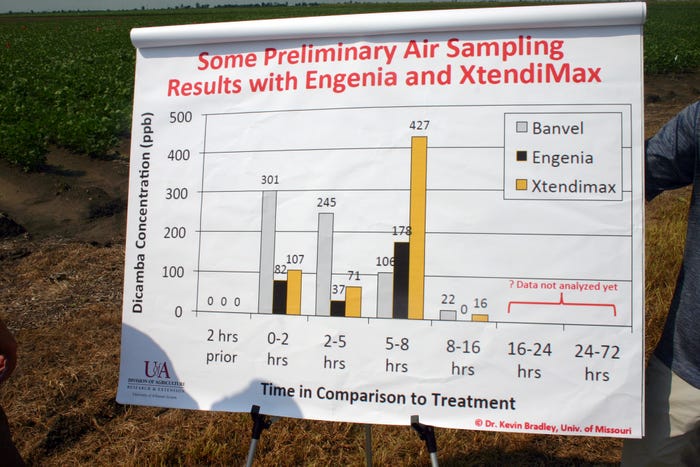
“Dr. Kevin Bradley in Missouri has also looked at this. He made an application of Banvel in a field, Engenia and Xtendimax. What he found is Banvel very quickly volatilized. Five hours later, there was increased volatilization of Engenia and Xtendimax.
“(Bradley) is currently analyzing data he has from 16 to 24 hours, as well as 24 to 72 hours after application. I believe he’ll make that data available when it’s ready.
“So, can we spray Engenia or Xtendimax that potentially volatilizes in a correct manner under warm conditions like we have in Arkansas and have the products stay put?
“There’s been a lot of talk about inversions. Often what can happen is you can make a labeled application at noon one day in a 3 mile-per-hour wind. But an inversion occurs that night and the material that has volatilized during the day can move over thousands of acres. Once the inversion dissipates the next day, the material sits down.
“We’ve all heard the talk about ‘uniform symptoms from turnrow to turnrow.’ That’s because of the inversion — the material sits down in a uniform manner.”
About the Author(s)
You May Also Like




